BAISAKHI RECIPES
Our Baisakhi Recipes section contains a variety of traditional Baisakhi recipes which are easy to make and tasty to the tongue. Baisakhi is a time for fun, frolic and food, the Punjabi way. Baisakhi otherwise called as Vaisakhi is a double celebration to mark the harvest festival as well as the Sikh New Year.
On this festival day people thank mother Goddess for giving them a bumper harvest. On the day, the people belonging to the Sikh community and Punjabis visit Gurudwara and offer prayers. The air is filled with festivity and gaiety. Right from the starters to the desserts, each Punjabi recipe is unique for its taste, preparation and aroma. Choley bhature, makki ki roti and sarson da saag, kheer are some of the popular recipes that the people love to cook, during the festival of Baisakhi. Apart from being unique for the festival, they are easy to prepare. The traditional Punjabi recipes are characterized by spicy taste, strong aroma and the generous use of ghee. In this section, we have provided the easy recipes for some of the most popular Baisakhi recipes, which would delight your taste buds on the occasion of Baisakhi.
CHOLEY BHATURE
Choley bhature is a lip-smacking and spicy recipe that is prevalent in the northern parts of India. A combination of choley (chick peas) and bhature (fried breads that resemble poori), the dish is a typical Punjabi food, which is usually eaten as a breakfast or lunch, accompanied with lassi. The dish is served with onions and pickle. It has emerged as one of the popular street foods in northern India and a hit in the college campuses across the region. On the glorious occasion of Baisakhi, eating choley bhature is a nice way to kick-start the day. Go through the article and know how to make choley bhature.
 Ingredients
Ingredients
- 2 cups All purpose flour (Maida)
- 1 pouch Yeast
- 1 cup Yogurt
- 2 tbsp Vegetable Oil
- 1 small can Garbanzo beans
- 1/2 tsp Ginger paste
- 1/2 tsp Garlic powder
- 1 tsp Cumin seeds
- 2 tbsp Oil
- 2 tbsp Cilantro
- 6-7 Mint leaves
- 1/2 tsp Turmeric Powder
- 1/2 tsp Chilly Powder
- 2-3 Bay Leaves
- 2-3 Cloves
- 1/2 tsp Garam Masala
- 1 Medium-sized finely chopped onion
- 1 Big tomato
- 1 1/2 cup Water
- Salt to taste
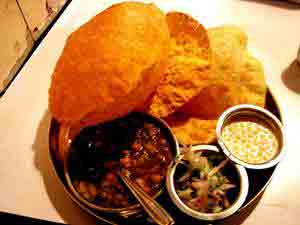
![]() Method
Method
- Take yeast and soak in lukewarm water for 5-10 minutes.
- Take all other ingredients and mix well. To this add the yeast and make a soft dough like for chappatis. If need be add a little water and keep aside for 4-5 hours, the longer kept, the better it is.
- Roll like puri, but this needs to be kept thicker than poori. Fry like poori till both sides are golden brown.
- Take 2 tablespoons of oil in a pressure cooker and heat it.
- Add garlic powder and make it dark brown. Then add cumin seeds fry till they start spluttering. Now add bay leaves and cloves. Add diced onions. Fry then till they are light brown.
- Now add the rest of ingredients including water except the cilantro and mint leaves. Close the pressure cooker and wait for 3 whistles to come or cook for 5-7 minutes. Also garnish with thinly sliced long pieces of onion and a piece of lemon split up into 4 pieces.
COCONUT LADOO
Coconut ladoo is a melt-in-the-mouth sweet dish, widely popular in the northern states of India. It is a true delight for the taste buds of the people with a sweet tooth. Coconut ladoos, as the name suggests, are balls made out of coconut, which is combined with suji (semolina) and sugar. The basic recipe remains the same, which makes it easy to learn and try. Moreover, it is a simple recipe that doesn't consume much time. While coconut ladoo is generally made by using generous amounts of ghee (clarified butter), you can also ensure a similar taste, by using condensed milk. Go through the following lines and know how to make coconut ladoo.
 Ingredients
Ingredients
- 300 grams grated fresh coconut(about 1 1/2 cups)
- 1 tin Condensed Milk
- 200 grams (1 cup) suji (semolina)
- 1 cup powdered sugar (200 grams)
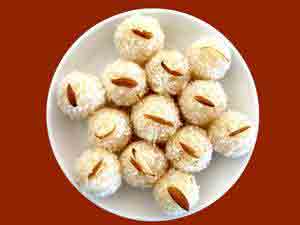
![]() Method
Method
- Dry-roast the semolina in a kadhai or a flat bottomed vessel. As soon as it starts to get slightly brown, take it out and keep it aside.
- Add one cup grated coconut in the semolina. Keep the rest to wrap the ladoos for later on. Let the mixture cool a bit.
- Mix the ground sugar after a while. Add 3/4 tin Milkmaid and mix well.
- Now add all the rest of the ingredients and mix well.
- Make small balls of the mixture, about the size of a table tennis ball.
- Roll the ladoo in the dry coconut powder that we kept aside earlier.
- Keep in refrigerator once done. Serve it with hot puri.
DRY FRUIT KHEER
Kheer is a traditional Indian sweet dish, which is typically made by boiling rice or broken wheat with milk, sugar and flavored with cardamom, saffron etc. Many variations can be brought about to the basic recipe of kheer, which is served as dessert after a sumptuous meal. No matter what the festival is, kheer finds a special place in the menu. It is very simple to prepare and the best recipe to experiment with, for the people, who are fond of cooking. One of the variations of the dish is the dry fruit milk kheer, in which, dry fruits are used as the chief ingredients. So, this Baisakhi, add sweetness to your celebrations by preparing the dessert. Go through the simple recipe given below and know how to make dry fruit kheer.
 Ingredients
Ingredients
- 1 liter milk
- 3/4 cup sugar
- 1/4 tsp. cardamom powder
- 15 strands saffron crushed, soaked in 1 tsp. hot milk
- 10-12 raisins
- 10-12 currants
- 10-12 almonds slivered
- 10-12 pistachios, slivered
- 5-6 dried peaches, quartered
- 5-6 dried apricots, nut removed, broken to bits
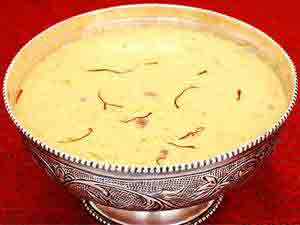
![]() Method
Method
- Soak the raisins, currant, peaches, apricots, in hot water for 10 minutes.
- Boil milk, with cardamom, saffron and sugar for 10 minutes.
- Drain the soaked dry fruit, add to the boiling milk, and stir gently.
- Simmer, stirring occasionally, for 5 minutes.
- Add almonds, pistachios, and take off from fire. Serve hot.
MAKKI KI ROTI
Makki ki roti (pan-fried corn bread) is a very popular dish in northern parts of India, especially Punjab. The roti is served straight off the griddle and is topped with lip smacking fresh homemade butter. Makki ki roti is often accompanied by sarson da saag - the duo makes a sumptuous breakfast. The Punjabi corn bread recipe is easy to learn. You may either consume the roti as such, or stuff them with grated radish. Makki ki roti and sarson da saag would serve as a delicious breakfast on the glorious occasion of Baisakhi. Explore the easy recipe of Makki ki roti given in the following lines and know how to make the bread.
 Ingredients
Ingredients
- 2 cups Corn Flour (Makki ka atta)
- Grated Radish
- Salt (optional)
- Warm Water
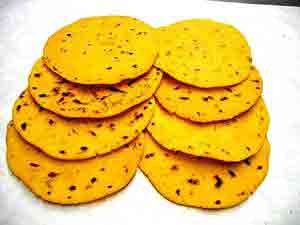
![]() Method
Method
- Knead the makki (corn) ka atta with warm water just before cooking the rotis.
- While kneading, add some grated radish and salt. To roll it, put a square of polythene paper on the kitchen platform.
- On this put a ball of the kneaded dough. Cover with another piece of polythene and then press with the ball of your palm till you get the size of a roti.
- This roti is slightly thicker than the normal roti. Remove the polythene cover and transfer the roti to a hot tava (skillet). Cook on low heat, turning till both sides are roasted.
- Apply some ghee.
PINDI CHANA
The traditional North Indian cuisine is renowned for its unique preparation, taste, aroma and the myriad variations that are brought about to the receipes. People living in the northern parts of the country are known for their inclination towards lavish feasts comprising of spicy, lip-smacking dishes. Pindi chana, native to the northern parts of India, is one such dish, which is full of 'firing' spice. Typically prepared by using aromatic spices, pindi chana (a dish of chick peas) allures one with its aroma. If garnished attractively, it would surely grab the attention of your guests. The wonderful dish that can very well fit into the menu meant for the lunch on Baisakhi. As a side dish, pindi chana can go well with puri, chapatti and bhature. Read on to explore how to make pindi chana.
 Ingredients
Ingredients
- 1 cup Chickpeas (Chole)
- 1 Tea Bag or 1 tbsp Black Tea Leaves tied in a cheesecloth
- 21/2-inch Ginger, 3/4th of it shredded finely for garnish
- 2-3 tbsp Oil
- 2 Onions, chopped
- 2 tsp Garlic, finely crushed
- 2 Green Chilies, sliced
- 3 medium sized Tomatoes, chopped
- 2 tsp Ground Coriander
- 11/2 tsp Ground Cumin
- tsp Turmeric Powder
- 1/2 - 1 tsp Red Chili Powder or as per taste
- SALT to taste
- tsp Garam Masala
- Finely chopped Coriander Leaves
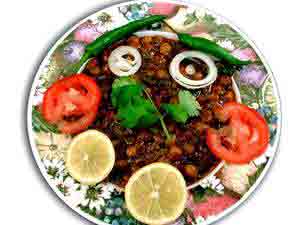
![]() Method
Method
- Soak Chole in water overnight or for about 6 hr.
- Cook the chole with salt and enough water in the cooker for about 20 minutes or till fully done. Drain, reserving 1 cup of cooking liquid.
- Finely chop the remaining ginger. Heat oil and sauté onions till golden, then add garlic and chopped ginger and green chilies. Sauté for 5 minutes.
- Add tomatoes, coriander, cumin, turmeric and chili powder and sauté over low heat until the oil separates.
- Add chole, the reserved cooking liquid, salt and half of the coriander leaves.
- Simmer, uncovered until the liquid has been absorbed.
- Add a pinch of garam masala and serve chole sprinkled with the remaining garam masala, coriander leaves and shredded ginger.
- Serve it with hot puri.
POORI
Fried food is something inevitable from the north Indian cuisine. For the habitants of northern part of India, wheat is the staple food and that is why, the main dishes are primarily made of wheat. Among the main dishes made of wheat, roti and puri stand prominent. Made of wheat dough, puri is the traditional fried Indian bread, served with a variety of side dishes, such as aloo subzi (potato curry), chole (chick pea curry) etc. Puri is an easy-to-make recipe and its variations are bhature and kachori. In order to make crispy puris, you need to know the right consistency of the dough as well as the way of rolling out the kneaded dough. Go through the article to get an easy recipe of puri.
 Ingredients
Ingredients
- 2 1/2 cups Chappati flour
- 2/3 cup Water at room temperature
- Ghee for brushing the bread while rolling out the dough
- Oil for deep frying
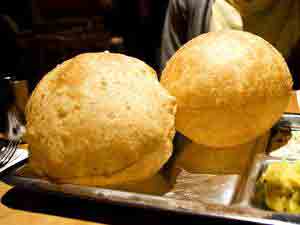
![]() Method
Method
- Put flour in a large bowl. Make a well in the middle and pour in a stream of water in the center. Use one hand to mix the flour and water in a rotating motion from the center of the bowl outward, until the dough is moist enough to be gathered into a rough mass.
- Wet hands and continue until the mixture cleans the sides of the bowl and has become a non sticky dough.
- When the dough is kneaded, it will be elastic and silky smooth. To test the dough, press it lightly with a fingertip. If it springs back, it is ready to be rested. Resting the dough is the last step and allows the dough to relax and absorb the water and kneading.
- Rest the dough for 1/2 hour in warm temperature and 1.5 hours in cold climates. Cover with a wet towel so the dough does not dry out. The rested dough is light and springy, less resistant to being rolled out into the thin rounds.
- Knead dough a little again. Dough should be stiff enough to roll without extra flour.
- Make small balls of the dough and cover them with damp cloth.
- Take one ball of dough and dip a corner of ball in melted ghee or oil and roll it out into 4 to 5 inches round.
- Repeat the same process to roll out all pooris.
- Heat plenty of oil in a kadhai until very hot.
- Put in a poori and immediately start flickering hot oil over the top of it with a spatula so that it will swell up like a ball.
- This should take only a few seconds. Flip the poori over and cook the other side until golden brown.
- Serve hot with pindi choley or other vegetables.
SARSON KA SAAG
In Punjab, you will find makki ki roti and sarson ka saag being served as a breakfast at every other household. The duo makes a heavy breakfast as well as a sumptuous lunch. It is a special treat for the people living in the northern parts of India, where wheat is one of the staple foods. Talking about sarson ka saag, the lip-smacking side dish is a reservoir of nutrients, because it is prepared by the combination of mustard greens, spinach and bathua (white goose-foot), three varieties of green leafy veggies that are rich in Vitamin A. The recipe also satisfies the taste buds, since it is finally topped with a block of fresh, homemade butter. The melt-in-the-mouth taste of sarson ka saag with makai ki roti would make the perfect breakfast for occasions like Baisakhi. Go through the following lines and know how to make sarson ka saag
 Ingredients
Ingredients
- 1 kg Sarson (mustard greens), chopped finely
- 1/4 kg Spinach, chopped finely
- 2 cm piece Ginger, minced
- 4 cloves Garlic minced
- 2 Green Chilies, minced
- 2 Red chilies
- 2 tbsp Gram Flour, sieved
- 1 tbsp Butter
- Ghee
- Salt to taste
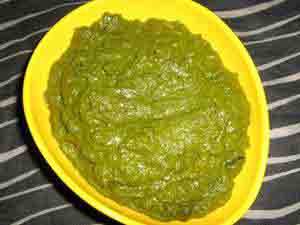
![]() Method
Method
- Boil both the greens till soft. Remove excess water, mash the leafy vegetables well and reserve.
- Heat 4 tbsps ghee and add ginger, garlic, green chillies and broken red chillies.
- When the masala has been browned, add the mashed saag and salt.
- Mix the gram flour in a little water and add to the saag.
- Simmer for at least 30 minutes.
- Serve hot, topped with a spoon of butter, with makki (maize flour) ki roti
TIL KI GAJAK
India is famous for its wide variety of sweet dishes. Each region is famous for its indigenous dishes. Talking about the northern part of the country, there is a rich tradition of preparing sweets that are confined to the particular festivals. Til ke gajak is one such recipe, which is relished on festivals like Baisakhi and Lohri. Made of sesame seeds (til), til ke gajak is a traditional Punjabi dish, which may serve either as dessert or snack item. It can be prepared easily, because it requires only a few ingredients. However, you should take care of the consistency of the jaggery-sesame mixture, because carelessness might spoil the dish. Go through the following lines and learn how to make til ke gajak.
 Ingredients
Ingredients
- 1 cup Sesame
- 3/4 cup Jaggery
- 1/2 tsp Cardamom Powder
- 2 tbsp ghee
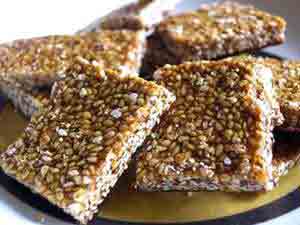
![]() Method
Method
- Roast sesame on low flame stirring continuously to avoid it from spluttering out of the pan.
- Boil jaggery in 1/2 cup water to form thick syrup.
- When done, check its consistency by putting a drop of the syrup in a dish of cold water. If the drop stays firm the consistency is right.
- Add the roasted sesame to the syrup. On a rolling board, spread a film of oil and spread the sesame-jaggery mixture.
- Flatten it to 1 cm thickness. When the mixture is sufficiently cooled, cut into square pieces. Store in an airtight container
TIL KI LADOO
Primarily used as a source of oil, sesame seeds could improve the taste, flavor and aroma of any dish to which they are added. In India, sesame seeds (til) are available in black and white color, each different from one another slightly, in terms of taste. Due to the nutritional value of sesame seeds and their crunchy taste, they are often used as the chief ingredient of ladoos and halvas and used as toppers for bun and homemade bread. If you travel to north India during festive seasons, you can try out the lip-smacking til ke ladoos, which are prepared on almost any occasion. Go through the following lines to get a simple recipe for til ke ladoo.
 Ingredients
Ingredients
- 4 cups Sesame Seeds
- 1/2 cup Water
- 1 1/2 cups Brown Sugar or Powdered Jaggery
- 1 cup Coconut, chopped finely into small pieces
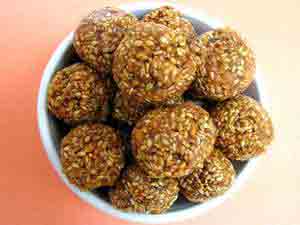
![]() Method
Method
- Dry roast the sesame seeds until light brown in color.
- Prepare syrup by boiling water and jaggery on low heat.
- Add coconut pieces and simmer until syrup becomes thick and sticky.
- Turn the heat off.
- Add sesame seeds and mix well.
- Allow the mixture to cool down.
- Shape into balls quickly.




